The results of a study on public involvement in environmental initiatives and its impact on environmental protection are presented in this article. Analyzing community participation in various environmental projects and evaluating the influence of this participation on reducing the pollution level of the Syrdarya River was the objectives of the study. As part of the research methodology, 263 respondents were polled about their involvement in various environmental moves, and the survey's results were analyzed.
The survey's primary findings demonstrate that a majority of participants engaged in multiple environmental actions simultaneously, demonstrating a broad range of interests and the willingness of individuals to actively contribute to environmental improvement. A particular focus is placed on the involvement of youth in these kinds of programs. The outcomes of the study enable us to gain a deeper comprehension of the dynamics and characteristics of citizen involvement in environmental projects, as well as to pinpoint avenues for future improvement.
The environmental issues that modern society is dealing with are getting worse and need careful, complete answers. In the attempts to protect the environment, environmental activism is crucial, and its significance is growing when considering sustainable development.
The most urgent environmental difficulties as well as the issues faced by those involved in environmental activities have been identified through a number of research on environmentalism and activism. Scholars like Bailey, Iyerly, and Forrester (1999), Shi and Bangpan (2022), Balunde, Perlaviciute, and Truskauskaite-Kunevi (2020), among many others, have contributed significantly to our understanding of the primary environmental aspects and the challenges associated with engaging in environmental activism.
Current work aims at analyze survey data in order to pinpoint the main issues that participants in environmental initiatives experience, as well as the most important environmental issues that need to be addressed right away. Our study is grounded in the public survey data, and via a methodical examination of the findings, we hope to pinpoint strategies for enhancing the local environment and promoting citizen participation.
River restoration and other natural resource conservation are greatly aided by environmental advocacy (Reis, P., 2020). The health of rivers affects many populations' livelihoods and well-being in addition to the environmental services they offer. Thus, it is strategically important to research how environmental activism affects rivers in order to create conservation and protection strategies that work. The effectiveness of environmental protection measures is significantly impacted by increased public knowledge and active participation in environmental activities. (T. M. Schusler & M. E. Krasny, 2008) The motivations and interests of citizens in taking part in environmental actions will be studied in order to determine what variables make society mobilize effectively to conserve rivers and other natural resources.
Methodology
The survey's methodology, inspired by Oxford University Press's Social Research Methods (Bryman, A., 2016), aimed to assess the level of environmental activism in Tajikistan and the challenges faced by participants. The questionnaire covered demographic details like age, gender, and prior environmental advocacy involvement. Prior research on environmental activism guided our selection of criteria. We drew insights from studies such as «Sustainability in Youth: Environmental Considerations in Adolescence and Their Relationship to Pro-environmental Behavior» and «Public awareness and support for environmental protection-A focus on air pollution in peninsular Malaysia». The survey was conducted online via the Google Forms platform, ensuring anonymity to encourage honest responses. It was widely shared among eco-activist communities through platforms like Facebook, Instagram, Telegram, and e-newsletters to ensure a representative sample. Quantitative and qualitative methods were employed to analyze the collected data. Descriptive statistics were used for quantitative analysis, while thematic organizing was employed to identify trends and themes in qualitative responses.
Objectives & Results
According to the aims of the study there was few objectives:
- Identification of the main challenges and obstacles faced by the participants of environmental activism.
- Analyzing the most pressing environmental problems that require attention and actions of civil society.
- Identifying the key strategies and actions needed to effectively address the problems of preserving and preventing pollution of the Syrdarya River.
- Assessing the role of environmental activism in the conservation of the Syrdarya River and its impact.
- Development of Proposals and Recommendations to improve the situation and stimulate citizens' activity in solving environmental problems
As a result of the survey in total 263 ecoactivists around Tajikistan responded to the poll. Tables 1 and 2 provide an overview of important demographic data, including the distribution of age and gender. (Survey Respondents' Demographic Details)


Regarding participant challenges and levels of environmental action, the survey's results showed a number of significant data for further analysis. Most of the respondents stated that they were involved in various kinds of environmental activism; among them, 47 % indicated that they were involved in general clean-up projects. The data that among the most popular actions were general (subbotnik) indicate that this type of activity is widespread and citizens' readiness for collective efforts to improve the environment is high. However, it is necessary to consider this phenomenon from a critical point of view, given that such events are often organized within the framework of a state initiative and have a necessarily coercive character.
Widespread participation in the clean-up days may indicate citizens' increased awareness of environmental issues and willingness to take part in improving the environment. However, it should be taken into account that some participants may have taken part in the clean-up days not of their own volition, but under pressure from public or state structures.
It is also worth noting that garbage collection and tree planting actions, in which 25 % and 17 % of respondents participated, respectively, indicate a significant interest of citizens in improving the environment and a willingness to take an active part in activities aimed at this goal. However, participation in animal protection and conservation actions (7 %) and only 2 % in promotion campaigns, and educational initiatives are relatively low, which may indicate less widespread interest in these types of environmental activities among respondents.
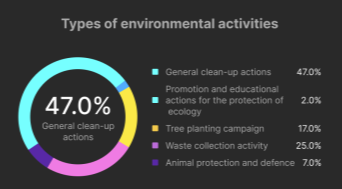
In the process of analyzing the various factors influencing citizens' participation in environmental actions, we examined the barriers that may influence citizens' decision to take an active part in environmental initiatives. However, based on this data, we can conclude that there are several key issues that are obstacles and difficulties that ecoactivists are faced to.

Data were also obtained to analyze the level of awareness among ecoactivists, according to which it can be concluded that the majority of activists believe that strengthening penalties and fines is a more effective measure for preventing river and environmental pollution. According to the survey of ecoactivists, 30 % of respondents noted that they lack precise information, which is also indicative of poor awareness.

The analysis of the issue of awareness among ecoactivists was also considered during the study of the role of activists in addressing real environmental problems — over 42 % of respondents expressed uncertainty. However, the overwhelming majority, 98 %, agreed that ecoactivists contribute more to the application of preventive measures to prevent pollution of the Syrdarya River. This combination of responses may indicate an ambiguous perception of the role of ecoactivists in addressing river pollution issues. For example, responding «do not know, not sure» may reflect uncertainty or lack of information among respondents regarding the activities of ecoactivists.
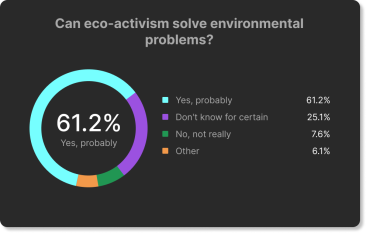
The study also showed that there is an ambiguity in the perception of the role of ecoactivists in society — some see them as key actors in solving problems, while others consider them incapable of bringing real change, recognizing their role only in attracting public attention to the problem.
These results may indicate the need for information campaigns and educational programs to increase public awareness and understanding of the role and importance of ecoactivism in combating river pollution problems.
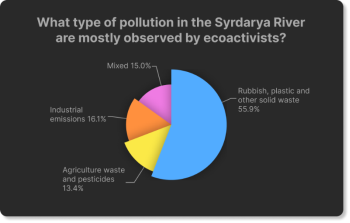
Indicators of ecoactivists' awareness level were questions about the types of pollutants in the Syrdarya, according to which more than 56 % of respondents stated that the main type of garbage is solid waste, including plastic
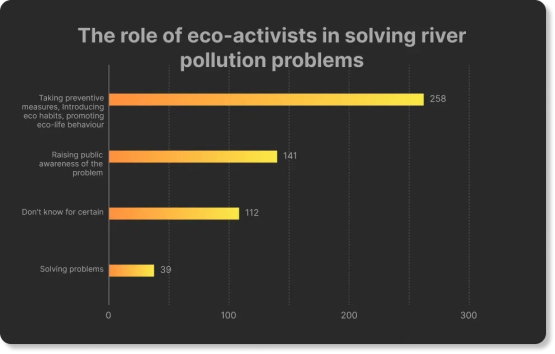
According to ecoactivists in northern Tajikistan, the most effective measures to preserve and prevent pollution of the Syrdarya River are separate collection and utilization of waste, as well as compliance with environmental standards in work or business.
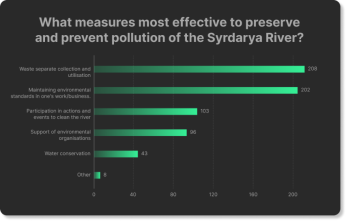
Possible reasons for the low awareness of ecoactivists may be relatively short activity in ecoactivism. According to the statistics obtained, more than 80 % of the respondents are involved in ecoactivism from time to time, and only 8 % stated that they have been involved in ecoactivism for more than 3 years and are quite active, and most likely it is this layer that is committed to the ideas of ecoactivism.
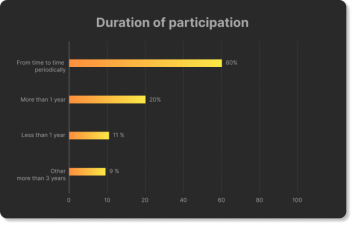
After data collection and analysis, the following results were obtained, which can be used for the development of ecoactivism and its further use as a tool to prevent pollution not only of the Syrdarya River but also of the environment in Tajikistan.
According to the survey results relatively equal gender participation in ecoactivism was revealed. And the majority of ecological movement participants are young people under 35 years old. The level of awareness and education of respondents is ambiguous and requires additional training and inculcation of greater commitment to ecoactivism, which unfortunately we do not observe probably due to the problems and difficulties faced by ecoactivists in Tajikistan. Also, the lack of commitment to the idea of ecoactivism was revealed, as most participants of environmental actions admitted that they are involved in environmental activities (general subbotniks) on an ad hoc basis and most often they are mandatory, which is initiated by the relevant government agencies.
Overall, the information and statistics that were gathered during the survey might be utilized to enhance environmental activism and address environmental issues in the area by means of additional investigation and recommendation-making.
The results of our study reveal a number of interesting aspects that deserve further discussion. For example, in comparison with the work of Schusler, T.M., & Krasny, M.E. (2008). «Youth Participation in Local Environmental Action: An Avenue for Science and Civic Learning?» and Shi, Y., & Bangpan, M. (2022). «Young people's participation experiences of technical and vocational education and training interventions in low- and middle-income countries» our results also revealed the multidisciplinary nature of citizen participation in environmental action. For example, the study «A Systematic Literature Review on the Participation Aspects of Environmental and Nature-Based Citizen Science Initiatives. Sustainability» also indicates the diversity of citizens' motives and interests in the environmental sphere.
It should also be noted that, according to our results, there are common trends with the conclusions of the research findings in the article «Effective Citizen Participation in Environmental Issues. State and Local Government Review» regarding the influence of education and social status on participation in environmental actions. However, it should be noted that there are also significant differences related more to the state system and cultural differences, which requires additional research in order to derive a precise correlation between these factors.
Based on our results, several directions for further research can be identified.
This includes analyzing a broader range of factors that influence participation in environmental actions, as well as investigating the effectiveness of specific initiatives and their impact on the environment.
Conclusion
This study is an analysis of citizen participation in environmental actions and its impact on rivers and the environment. The results of our study confirmed the diversity of motivations and interests behind citizens' participation in such events.
The analysis of the obtained data showed that a significant proportion of respondents participated in several environmental actions, which indicates the willingness of citizens to take an active part in improving the environment. However, it is important to take into account that some activities, such as general clean-up days, may have a coercive nature for some participants, which may also affect the level of participation in environmental activities and commitment to ecoactivism.
Analyzing the responses to the survey questions on environmental activism allows us to form a clear picture of participants' involvement and preferences in environmental initiatives.
The data shows that the overwhelming majority of respondents participate in environmental actions periodically, which indicates an active but superficial interest of citizens in environmental issues.
Our study also revealed differences in the interests and motivations of the participants of the actions, as well as in their level of awareness of environmental issues. This underscores the need for personalized approaches when developing strategies to engage citizens in environmental action.
Despite limitations, including limited sample size and survey duration, our results provide valuable information on the state of environmental activism among the population and its impact on the environment. The data obtained can be used to develop effective strategies for the protection and restoration of rivers and water bodies, as well as to engage the population in environmental initiatives.
References:
1. Bailey, P., Yearley, S., & Forrester, J. (1999). Involving the public in local air pollution assessment: a citizen participation case study. International Journal of Environment and Pollution, 11, 290. https://doi.org/10.1504/IJEP.1999.002262
2. Balunde, A., Perlaviciute, G., & Truskauskaite-Kunevi, I. (2020). Sustainability in Youth: Environmental Considerations in Adolescence and Their Relationship to Pro-environmental Behavior. Front. Psychol., 11. https://doi.org/10.3389/fpsyg.2020.582920
3. Bryman, A. (2016). Social Research Methods. Oxford University Press.
4. Chin, Y. S. J., De Pretto, L., Thuppil, V., & Ashfold, M.J. (2019). Public awareness and support for environmental protection—A focus on air pollution in peninsular Malaysia. PLOS ONE, 14(3). https://doi.org/10.1371/journal.pone.0212206
5. Johnson, M.F., Hannah, C., Acton, L., Popovici, R., Karanth, K.K., & Weinthal, E.S. (2014). Network environmentalism: Citizen scientists as agents for environmental advocacy. Global Environmental Change-human and Policy Dimensions, 29, 235–245.
6. Kasymova, J.T., & Gaynor, T.S. (2014). Effective Citizen Participation in Environmental Issues. State and Local Government Review, 46.
7. Khatibi, F.S., Dedekorkut-Howes, A., Howes, M., et al. (2021). Can public awareness, knowledge and engagement improve climate change adaptation policies?. Discov Sustain, 2, 18. https://doi.org/10.1007/s43621–021–00024-z
8. Neas, S., Ward, A., & Bowman, B. (2022). Young people’s climate activism: A review of the literature. Front. Polit. Sci., 4. https://doi.org/10.3389/fpos.2022.940876
9. Reis, P. (2020). Environmental Citizenship and Youth Activism.
10. Schusler, T.M., & Krasny, M.E. (2008). Youth Participation in Local Environmental Action: An Avenue for Science and Civic Learning?
11. Schusler, T.M., Krasny, M.E., Peters, S.J., & Decker, D.J. (2009). Developing citizens and communities through youth environmental action. Environmental Education.
12. Shi, Y., & Bangpan, M. (2022). Young people’s participation experiences of technical and vocational education and training interventions in low- and middle-income countries: a systematic review of qualitative evidence. Empirical Res Voc Ed Train, 14(8).
13. Vasiliades, M.A., Hadjichambis, A.C., Paraskeva-Hadjichambi, D., Adamou, A., & Georgiou, Y. (2021). A Systematic Literature Review on the Participation Aspects of Environmental and Nature-Based Citizen Science Initiatives. Sustainability, 13(13). https://doi.org/10.3390/su13137457







